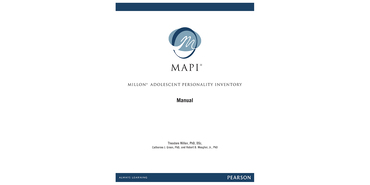The Millon® Adolescent Personality Inventory (MAPI®) is a normed assessment of adolescent personality characteristics. Guidance on using this test in your telepractice.
Millon Adolescent Personality Inventory
MAPI
The Millon® Adolescent Personality Inventory (MAPI®) is a normed assessment of adolescent personality characteristics. Guidance on using this test in your telepractice.Choose from our formats
Test forms reports
Booklets, record forms, answer sheets, report usages & subscriptions
3 options
Support materials
Manuals, stimulus books, replacement items & other materials
2 options
All products
All tests and materials offered for MAPI
5 options
